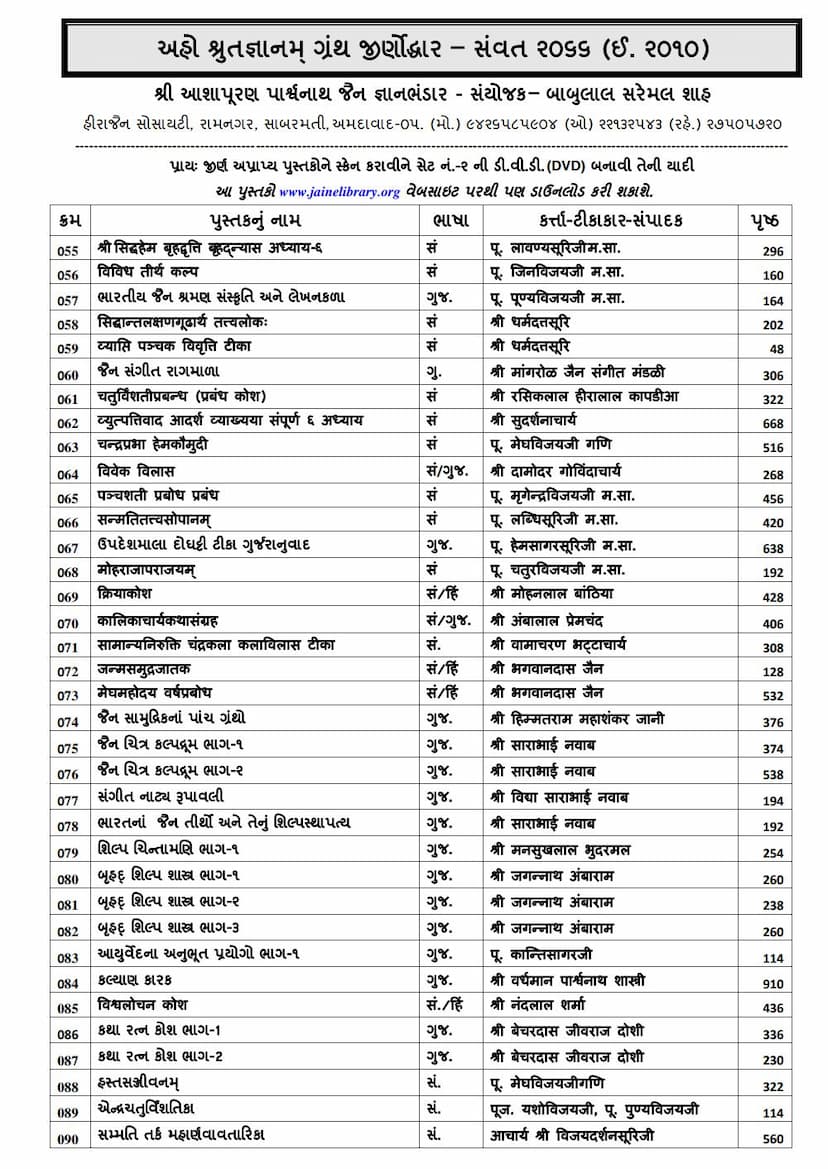Vivek Vilas
Added to library: September 2, 2025

Summary
Here's a comprehensive summary of the Jain text "Vivek Vilas" by Damodar Pandit, based on the provided pages:
Book Title: Vivek Vilas (विवेक विलास) Author: Jinadatta Suri (original text), Pandit Damodar Govindacharya (Gujarati translation) Publisher: Devidas Chhaganlalji Catalog Link: https://jainqq.org/explore/008466/1
Overall Purpose: "Vivek Vilas" is a comprehensive Jain text that aims to provide guidance on virtuous living and conduct for lay individuals (Grihasthas) within the framework of Jain principles. It covers a wide range of topics, from daily routines and seasonal practices to ethics, societal interactions, and even basic principles of building and astrology, all with the ultimate goal of spiritual progress and well-being.
Key Themes and Content Breakdown:
The book is structured into twelve sections called "Ullas" (chapters), each focusing on a distinct aspect of life:
- Mangalacharan (Invocation): Begins with auspicious verses praising the divine and the teacher.
- Prashansa of the Granth (Praise of the Book) and Author's Intent: Explains the purpose of the book – to provide essential knowledge for a well-rounded life and to guide people towards righteousness.
- Daily Routine (Dinacharya): This is a significant portion, detailing how to conduct oneself from waking up in the early morning until sleeping at night. It includes:
- Morning ablutions and rituals (bathing, cleaning, etc.)
- Hygiene practices (teeth cleaning, gargling, etc.)
- Proper conduct throughout the day (eating, interacting with elders, worship, etc.)
- Guidelines for meals and rest.
- Evening routines and bedtime preparations.
- Seasonal Practices (Ritucharya): Provides guidance on how to adjust one's diet, activities, and lifestyle according to the six seasons of the year (Vasant, Grishma, Varsha, Sharad, Hemant, Shishir).
- Yearly Practices (Varshacharya): Discusses general guidelines for the entire year.
- Life Cycle Practices (Janmacharya): Covers aspects of life from birth to death.
- Causes of Sin and Merit (Pap and Punyakaran): Explains the actions that lead to negative (sinful) and positive (meritorious) karmic consequences.
- Spiritual Reflection and Meditation (Adhyatmavichar and Dhyan): Delves into the principles of self-awareness and contemplation.
- Conduct in Society (Sabha-vichar): Offers advice on how to behave appropriately in social gatherings and interactions.
- General Precepts (Samanya Upadesh): Provides overarching ethical and moral guidelines.
- Rituals and Devotion (Upashraye Javu, Guru-sevan, Dev-darshan): Details the importance of visiting monastic quarters, serving the guru, and performing devotion to deities.
- Duties at the Time of Death and Afterlife (Mrityu Samayna Kartavya and Paralok Sadhan): Discusses the conduct and spiritual practices necessary for a good afterlife.
Author and Historical Context:
- The original text was written by Jinadatta Suri of the Vayada Gachha.
- It was composed to please King Udaysingh of Jakhalipur, his minister Devpal, and his adopted son Dhanpal.
- Based on historical references, Jinadatta Suri likely lived in the first half of the 13th century CE, as King Udaysingh passed away in 1231 CE.
- The Gujarati translation was done by Pandit Damodar Govindacharya.
- The book was published in 1854 (Vikram Samvat), corresponding to 1898 CE, by Devidas Chhaganlalji. It was printed at "The Diamond Jubilee Printing Press" in Ahmedabad.
Specific Highlights from the Provided Pages:
- Extensive Table of Contents: The provided pages include a detailed index (Anukramanika) that lists the subjects covered in each of the twelve Ullas, giving a clear overview of the book's breadth.
- Daily Routine Details: The early Ullas focus heavily on the minutiae of a layperson's daily life, including when to wake up, how to maintain hygiene, when to perform prayers and charitable acts, and even how to conduct oneself during meals.
- Astrology and Omens: The text incorporates elements of Jyotish (astrology) and Shagun (omens), particularly in the eighth Ullas, discussing auspicious times for building houses, the significance of various signs and omens, and the interpretations of snakebite locations and times.
- Social Ethics and Conduct: Various Ullas offer guidance on proper behavior in society, dealing with different types of people, respecting elders, and maintaining harmonious relationships.
- Importance of Dharma: A recurring theme is the paramount importance of Dharma (righteousness, duty) in all aspects of life for achieving spiritual merit, material prosperity, and ultimately, liberation.
- Wisdom from Saints and Sages: The text frequently refers to the teachings and sayings of ancient scholars and saints to support its advice.
- Self-Discipline and Mindfulness: Emphasis is placed on controlling the senses, mind, and actions, and cultivating virtues like patience, truthfulness, and non-violence.
- Dietary and Health Advice: The book offers advice on diet and health that is considered beneficial according to traditional Indian medical systems.
- Family and Societal Roles: It touches upon the roles and responsibilities within a family and society.
- Cautionary Tales and Examples: The text uses examples and potential consequences to illustrate the importance of following virtuous paths and avoiding negative actions.
In essence, "Vivek Vilas" serves as a practical guide for Jain householders, offering a holistic approach to life by integrating spiritual principles with everyday actions, social conduct, and even practical wisdom about the natural world and human behavior.